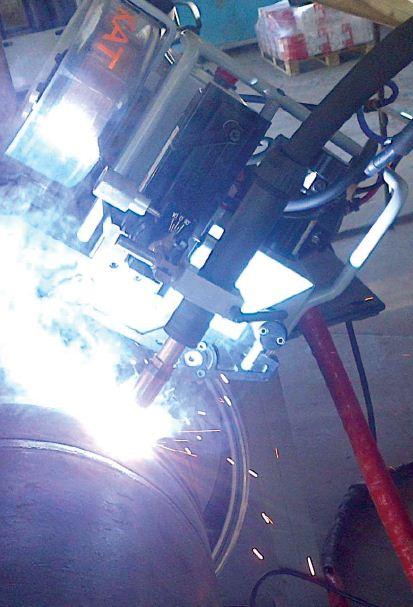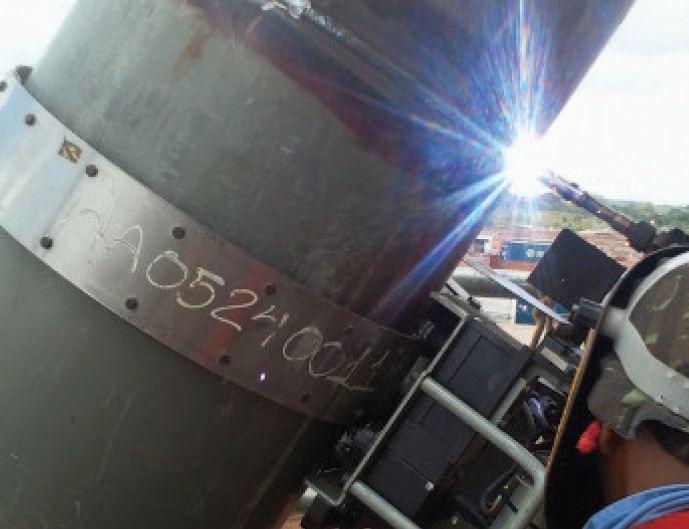- FMA
- The Fabricator
- FABTECH
- Canadian Metalworking
Automating in the field
The future of the oil and gas storage industry in Canada will depend on the success or failure of these projects.
- By Canadian Metalworking
- June 24, 2015
- Article
- Welding
Keystone XL, Line 9 Reversal and West to East Pipeline are three major pipeline projects Canada will continue to pursue over the next few years as the glut of oil production in the Mideast and U.S. force Canadian oil exports away from their tradition markets. With oil production landlocked in Alberta, the necessity for transport through pipelines or rail car has become a priority for the energy sector as well as Ottawa, as lower oil prices mean less tax revenue.
With the rush to get these proposals approved and start laying the foundation comes a huge focus on how these pipelines will actually be fabricated. Canada will continue to experience a decline in its skilled labor force over the next decade, and as such improved productivity and quality of work will be key in completing these projects on-time. With pipelines there is a huge amount of pre-fabrication being done to minimize the amount of work required in the field. Large column and boom systems designed to produce high-quality submerged arc welds (welds completed using flux were the arc is hidden from view) at a very high speed have made the pipe section fabrication very efficient. The pipe bevels can also be made in the shop and help to improve fit up during the final stages of the fabrication process when the field welding must be completed. Until recently, this is where the automation of the fabrication process would take a back seat.
The automated welding industry has been focused on developing a solution capable of withstanding the rigorous schedule the final phases of pipeline manufacturing put on the welder. Manual welding of a standard 24-inch diameter pipe with ½-inch wall thickness can take over 3-1/2 hours to complete, and this same process has a generally expected weld failure rate of upwards of 20 per cent. With advancements in automated welding technology, such as the Pipe KAT automate pipe welding carriage manufactured by Gullco, this time can be cut down to under 1-1/2 hours per joint. Further time and money is saved by reducing rework as a result of the consistent weld quality produced by this type of welding carriage.
An operator is able to preset the welding parameters, and from there the main focus is steering the arc and compensating for any irregular fit up in the pipe which is inherent in the production process. By using an automated welding carriage the welder is able to maximize his own efficiency completing more welds in a shorter period of time, as well as eliminate stops and starts (the source of most weld failures) and reduce the fatigue which is a natural part of the process. Pipeline welding can be very strenuous and often requires welders to be on their back or contorted to finish the final portion of the weld on the underside of the pipe.
For pipeline manufacturers and companies bidding on these projects automation means competitive pricing. By improving the efficiency of the welders, increasing productivity and quality, a manufacturer is able to compensate for unforeseen instances which compromise deadlines that are normally set with very aggressive timelines.
An overlooked benefit of welding automation is improved consumable consumption. With manual processes such as stick welding, the welding may use 3/4 of the welding electrode before it is exchanged for a new one, and the process itself leads to over welding. If even a ¼-inch of extra welding is produced per pass, when multiplied by the entire length of the pipeline this can result in hundreds of feet of extra electrode. With automation the operator is able to precisely control the weld width and speed to hundredths of an inch, and as a result the consistency of each weld and the deposition is comparable from each pass and each joint.
The future of the oil and gas storage industry in Canada will depend on the success or failure of these projects, and while environmental concerns have their part to play the overall success will depend on the contractors ability to maintain budget and timeline efficiencies to see the completion of the pipeline in time to keep Canadian oil relevant on a global scale. Welding automation, while not a new technology, has only recently seen a huge surge in the oil and gas sector as regulations have long kept these technologies from being a viable option. As we move forward with our thinking more projects will see automation incorporated into the budgetary and implementation phases.
Nick Drake is marketing manager with Gullco International
About the Author
subscribe now


Keep up to date with the latest news, events, and technology for all things metal from our pair of monthly magazines written specifically for Canadian manufacturers!
Start Your Free Subscription- Trending Articles
Portable system becomes hot tech in heat treatment

Cidan Machinery Metal Expo 2024 to be held in Georgia May 1-2

CWB Group launches full-cycle assessment and training program

Achieving success with mechanized plasma cutting

3D laser tube cutting system available in 3, 4, or 5 kW

- Industry Events
MME Winnipeg
- April 30, 2024
- Winnipeg, ON Canada
CTMA Economic Uncertainty: Helping You Navigate Windsor Seminar
- April 30, 2024
- Windsor, ON Canada
CTMA Economic Uncertainty: Helping You Navigate Kitchener Seminar
- May 2, 2024
- Kitchener, ON Canada
Automate 2024
- May 6 - 9, 2024
- Chicago, IL
ANCA Open House
- May 7 - 8, 2024
- Wixom, MI

















